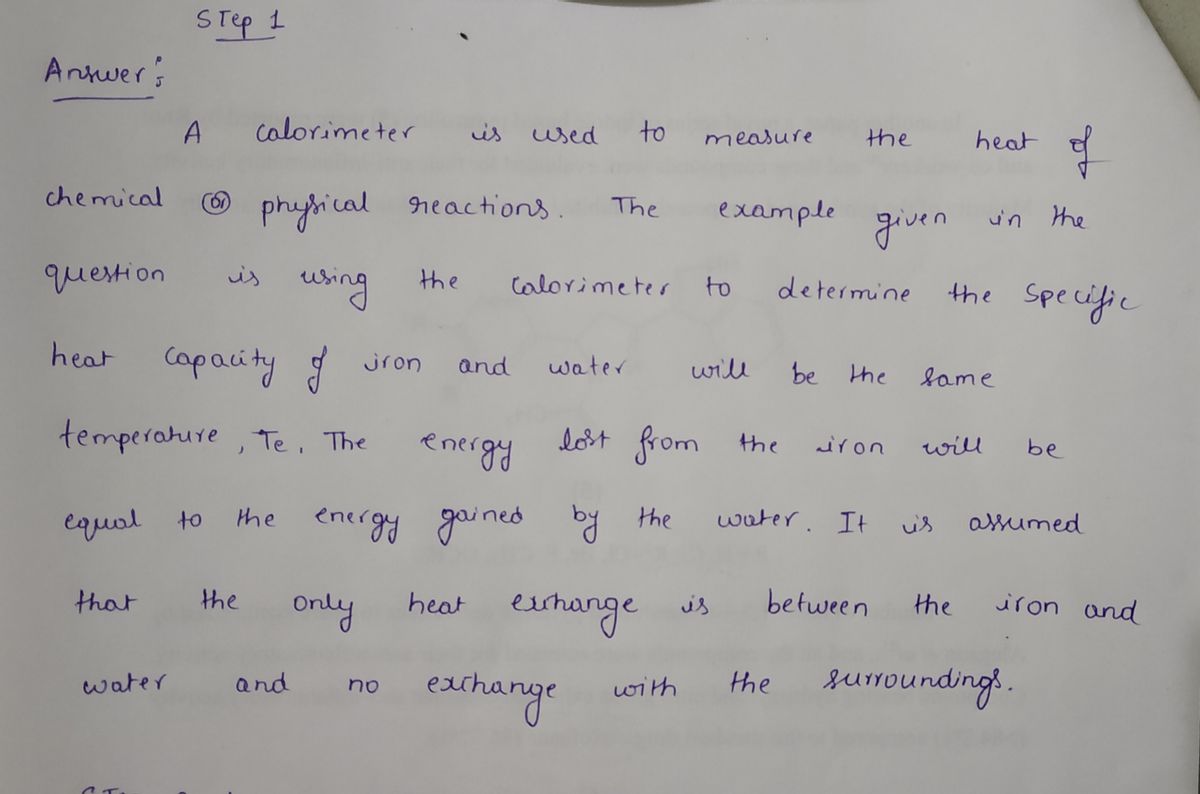Chemistry
10th Edition
ISBN:9781305957404
Author:Steven S. Zumdahl, Susan A. Zumdahl, Donald J. DeCoste
Publisher:Steven S. Zumdahl, Susan A. Zumdahl, Donald J. DeCoste
Chapter1: Chemical Foundations
Section: Chapter Questions
Problem 1RQ: Define and explain the differences between the following terms. a. law and theory b. theory and...
Related questions
Question
![**Calorimetry Experiment: Determining the Specific Heat Capacity of Iron**
**Objective:**
To calculate the specific heat capacity of iron using calorimetry.
**Materials:**
- A 51.9 g sample of iron
- A calorimeter
- 300.0 g of water
- Thermometer
- Insulated container
**Procedure:**
1. Insert the iron sample, initially at a temperature of 85.7°C, into a calorimeter containing 300.0 g of water at 15.0°C.
2. Monitor the temperature of the water until it reaches equilibrium, stopping at 16.7°C.
3. Ensure that the pressure remains constant at 1 atm throughout the experiment.
**Diagram Explanation:**
A simple diagram shows the arrangement in the calorimeter:
- The iron sample is submerged in water inside an insulated container.
- A thermometer is placed to measure the water temperature.
- There is a label indicating the position of each component: thermometer, insulated container, water, and sample.
**Calculation:**
Determine the specific heat capacity of iron, and round your answer to two significant digits.
**Input Area:**
Provide your answer as:
\[ \frac{\text{J}}{\text{g} \cdot °\text{C}} \]
**Note:**
This activity helps in understanding the energy transfer during the heat exchange process and introduces the concept of specific heat capacity.](/v2/_next/image?url=https%3A%2F%2Fcontent.bartleby.com%2Fqna-images%2Fquestion%2F3893932c-2434-47b4-9ff3-80ab3f986ca2%2F7fca9362-46b6-4d7d-a479-6e3e1dae6826%2Fwjq9fhi_processed.jpeg&w=3840&q=75)
Transcribed Image Text:**Calorimetry Experiment: Determining the Specific Heat Capacity of Iron**
**Objective:**
To calculate the specific heat capacity of iron using calorimetry.
**Materials:**
- A 51.9 g sample of iron
- A calorimeter
- 300.0 g of water
- Thermometer
- Insulated container
**Procedure:**
1. Insert the iron sample, initially at a temperature of 85.7°C, into a calorimeter containing 300.0 g of water at 15.0°C.
2. Monitor the temperature of the water until it reaches equilibrium, stopping at 16.7°C.
3. Ensure that the pressure remains constant at 1 atm throughout the experiment.
**Diagram Explanation:**
A simple diagram shows the arrangement in the calorimeter:
- The iron sample is submerged in water inside an insulated container.
- A thermometer is placed to measure the water temperature.
- There is a label indicating the position of each component: thermometer, insulated container, water, and sample.
**Calculation:**
Determine the specific heat capacity of iron, and round your answer to two significant digits.
**Input Area:**
Provide your answer as:
\[ \frac{\text{J}}{\text{g} \cdot °\text{C}} \]
**Note:**
This activity helps in understanding the energy transfer during the heat exchange process and introduces the concept of specific heat capacity.
Expert Solution
Step 1

Step by step
Solved in 2 steps with 2 images

Recommended textbooks for you

Chemistry
Chemistry
ISBN:
9781305957404
Author:
Steven S. Zumdahl, Susan A. Zumdahl, Donald J. DeCoste
Publisher:
Cengage Learning

Chemistry
Chemistry
ISBN:
9781259911156
Author:
Raymond Chang Dr., Jason Overby Professor
Publisher:
McGraw-Hill Education

Principles of Instrumental Analysis
Chemistry
ISBN:
9781305577213
Author:
Douglas A. Skoog, F. James Holler, Stanley R. Crouch
Publisher:
Cengage Learning

Chemistry
Chemistry
ISBN:
9781305957404
Author:
Steven S. Zumdahl, Susan A. Zumdahl, Donald J. DeCoste
Publisher:
Cengage Learning

Chemistry
Chemistry
ISBN:
9781259911156
Author:
Raymond Chang Dr., Jason Overby Professor
Publisher:
McGraw-Hill Education

Principles of Instrumental Analysis
Chemistry
ISBN:
9781305577213
Author:
Douglas A. Skoog, F. James Holler, Stanley R. Crouch
Publisher:
Cengage Learning

Organic Chemistry
Chemistry
ISBN:
9780078021558
Author:
Janice Gorzynski Smith Dr.
Publisher:
McGraw-Hill Education

Chemistry: Principles and Reactions
Chemistry
ISBN:
9781305079373
Author:
William L. Masterton, Cecile N. Hurley
Publisher:
Cengage Learning

Elementary Principles of Chemical Processes, Bind…
Chemistry
ISBN:
9781118431221
Author:
Richard M. Felder, Ronald W. Rousseau, Lisa G. Bullard
Publisher:
WILEY